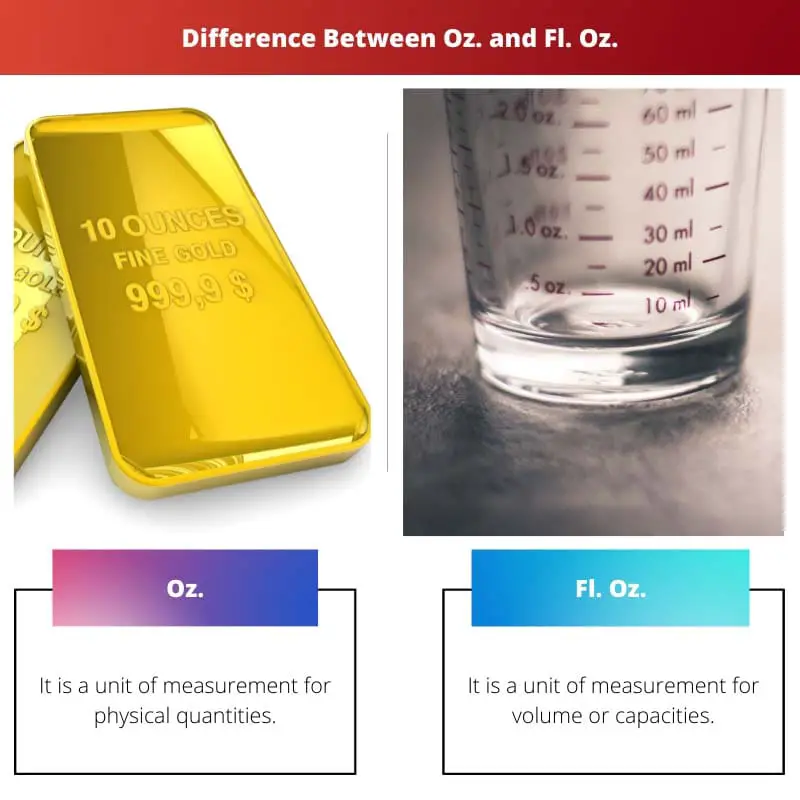
What’s the Difference Between Fl Oz and Oz?
Have you ever wondered what the difference is between fl oz and oz? Both are abbreviations for ounces, but they represent different measurements. Fl oz stands for fluid ounces, while oz refers to weight ounces. This distinction might be confusing and the terms are often used interchangeably, but they actually measure different quantities.
The most important thing to remember is that fluid ounces and weight ounces are not interchangeable. If a recipe calls for a certain number of fluid ounces, you cannot substitute the same number of weight ounces, and vice versa.
Fluid Ounces
Fluid ounces are a unit of volume, meaning they measure how much space a liquid takes up. One fluid ounce is equal to 29.57 milliliters.
Fluid ounces are commonly used to measure liquids, such as water, milk, and juice. They are also used to measure the volume of containers, such as bottles and cups.
Weight Ounces
Weight ounces are a unit of mass, meaning they measure how heavy something is. One weight ounce is equal to 28.35 grams.
Weight ounces are commonly used to measure the weight of solids, such as food, spices, and powders. They are also used to measure the weight of objects, such as packages and boxes.
The Difference Between Fluid Ounces and Weight Ounces
The difference between fluid ounces and weight ounces is that fluid ounces measure volume, while weight ounces measure mass. This means that two objects can have the same number of fluid ounces but different weights, and vice versa. For example, a cup of water has the same number of fluid ounces as a cup of sand, but the cup of water weighs more because it is denser.
The density of a substance is the amount of mass per unit of volume. Water has a higher density than sand, so a cup of water weighs more than a cup of sand, even though they have the same number of fluid ounces.
When to Use Fluid Ounces and Weight Ounces
It is important to use the correct unit of measurement when measuring liquids and solids. If you are measuring the volume of a liquid, use fluid ounces. If you are measuring the weight of a solid, use weight ounces.
Using the wrong unit of measurement can lead to inaccurate results. For example, if you are following a recipe that calls for a certain number of fluid ounces of milk, but you use weight ounces instead, you will end up with too much milk in your recipe.
Tips for Using Fluid Ounces and Weight Ounces
Here are a few tips for using fluid ounces and weight ounces correctly:
- Always pay attention to the units of measurement in recipes and other instructions.
- Use a measuring cup to measure liquids, and a kitchen scale to measure solids.
- If you are unsure of which unit of measurement to use, consult a conversion chart.
FAQ
Q: What is the difference between fluid ounces and weight ounces?
A: Fluid ounces measure volume, while weight ounces measure mass.
Q: How many fluid ounces are in a weight ounce?
A: There are 1.04 weight ounces in a fluid ounce.
Q: How many weight ounces are in a fluid ounce?
A: There are 0.96 fluid ounces in a weight ounce.
Q: Which unit of measurement is used to measure the volume of liquids?
A: Fluid ounces are used to measure the volume of liquids.
Q: Which unit of measurement is used to measure the weight of solids?
A: Weight ounces are used to measure the weight of solids.
Conclusion
Fluid ounces and weight ounces are two different units of measurement that are often confused. It is important to understand the difference between these two units and to use the correct one when measuring liquids and solids.
By following the tips in this article, you can avoid confusion and ensure that you are using the correct unit of measurement for your needs.
Are you interested in learning more about fluid ounces and weight ounces? Let us know in the comments below.

Image: www.fanpop.com

Image: askanydifference.com
Comparison Charts 2. The fl. oz. or fluid ounce is for measuring volume, and the oz. or simply dry ounce is for measuring mass. 3. A fl. oz. is equal to about 30 millilitres in the U.S. system and to about 28 millilitres in the imperial system. When stating it accurately, one U.S. fl. oz. is equal to 29.5735297 millilitres and one oz. is equal to 28.3495231 grams.